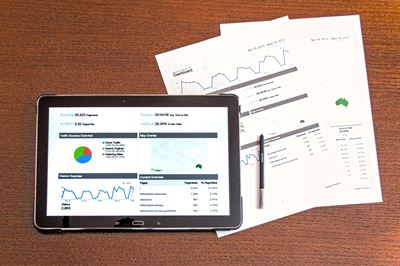Heat Level:  Mild: These tips are beginner-friendly.
Mild: These tips are beginner-friendly.
Bottom Line: The insights you get from Google Analytics are worth the time it takes to learn these few terms.
Do This: Flip through your Google Analytics reports and find answers to questions like:
How many people visit my site on a daily basis?
How are people finding my website?
What pages or listings are people viewing?
How long are they staying?
What locations are my site visitors in?
 These terms teach you all you need to know about your website's Analytics.In our last entry, we taught you how to install or gain access to Google Analytics. Now that you’ve got this tiny snippet of code, you get to see exactly what people are doing on your website.
These terms teach you all you need to know about your website's Analytics.In our last entry, we taught you how to install or gain access to Google Analytics. Now that you’ve got this tiny snippet of code, you get to see exactly what people are doing on your website.
Real estate brokers and agents can get a huge amount of value out of website stats. You can see which of your listings are getting the most traffic, how people are finding your website, which of your agents are getting the most page views, where people are dropping off… just to name a few of the possibilities.
(Don’t have Analytics or lost your login? This article’s for you.)
At first glance, Analytics looks like something NASA could use to launch a spaceship. But we promise that after reading these terms, you’ll understand what you’re seeing!
When you log into Analytics, you’ll start on the Home dashboard. This is a snapshot of your past seven days. Here is some vocabulary you’ll need to make sense of it:
Users: the number of different people who have come to your site.
Sessions: the number of visits to your site (one user can visit multiple times, which is why these numbers are different).
Bounce Rate: the percentage of people who leave after seeing only one page. They don’t take any other action before they exit.
Session Duration: the average time people spend on your website.
Page Views: the number of pages people visited on your site
Pages Per Session: the average number of pages people viewed during a single session.
Once you’ve gotten comfortable with these figures, you can explore the different “reports” in the left-hand menu. The date ranges for these reports can be changed using the date fields near the top right corner of each report page.
Here are the different reports and what you’ll find in them:
Real-Time: shows you stats on the people who are currently on your website. (Pro tip: if you want to make sure your Google Analytics are tracking, have your website open while you’re looking at the Real-Time window. You should be able to see yourself, unless you’re using a filtered view! Don’t worry, we’ll get to filters and views later in this series.)
Audience: gives you insights on who these people are, where they’re from, and what technology they’re using to view your site. (Keep in mind that this data is anonymous).
Acquisition: helps you see exactly how people are getting to your website.
Behavior: shows you what people are doing on your website, like which pages they’re viewing and how long they’re staying.
Conversions: this is a more advanced area which will require you to set up triggers on your website. We’ll come back to this topic in another post so you can learn how to track contact form submissions, video views, PDF downloads, and more.
It might take a while to get comfortable with all of the charts, graphs, and numbers. Google Analytics is an absolute powerhouse and the volume of data it provides is massive. Here are a few basic things you can look at, and where to find them:
How many people visit my site on a daily basis?
Audience Report > Overview.
How are people finding my website?
Acquisition Report > All Traffic > Channels
What pages or listings are people viewing?
Behavior > Site Content > All Pages
What locations are my site visitors in?
Audience > Geo > Location (this defaults to countries. To see cities, click Primary Dimension: City. If there’s a big difference between your service area and where your visitors are from, you might need to apply filters.)
Once you’ve spent some time flipping through the reports, you’ll see how incredibly helpful all of this data is. Here are some more advanced examples of what you’ll be able to track and measure:
Want to impress a seller? Show them how many sessions some of your listing pages are getting.
Paying for a billboard? You’ll be able to see if you get a spike in web traffic from that location.
Wonder if your Facebook ads are driving leads? Look at your traffic from Social.
Curious if people are clicking links in your emails? You’ll be able to see that as a referral source.
Now you know what works, what doesn’t, and what you need to fix or improve. And that is the power of Analytics.
Master these basics first. Then you’ll be ready to learn how to interpret your data, what red flags to look for, what are “good” and “bad” stats, and how to customize Analytics to answer all of your questions. If you have any questions in the meantime, our inbox is always open!